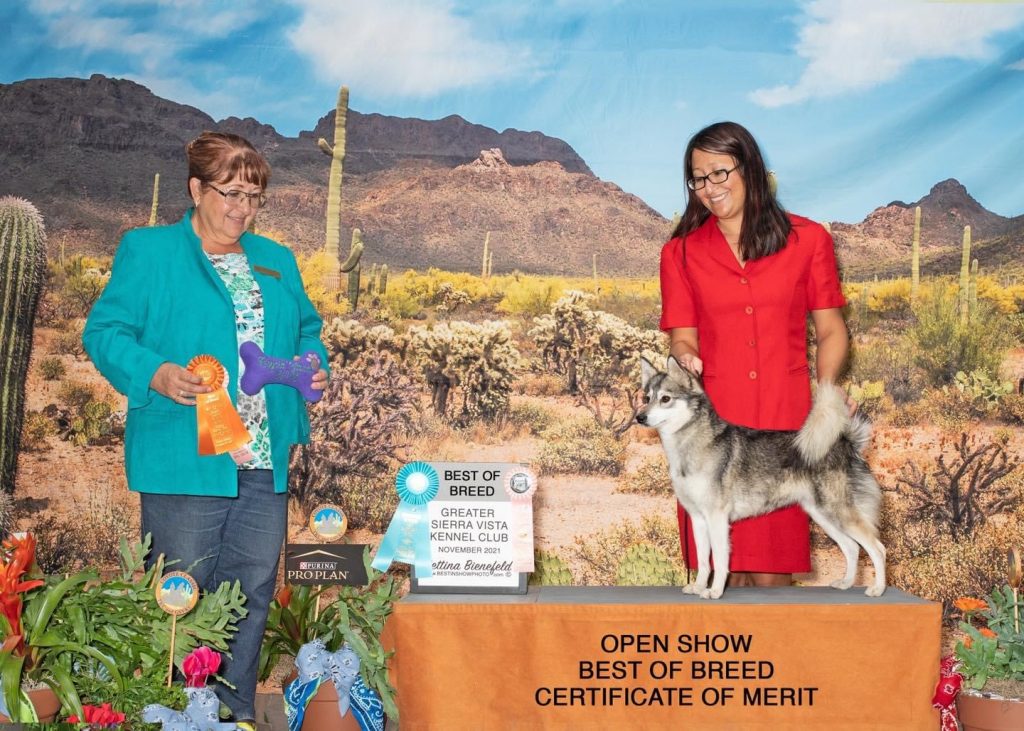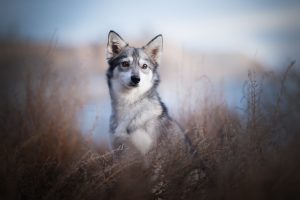Breeder Spotlight
By Jessica Freni
This week we’re exploring an upcoming AKC FSS breed- the Alaskan Klee Kai- with Breeder Jennifer of Thurisia.
In 2009, I learned about the Alaskan Klee Kai from a coworker. As it goes with most people in this breed, I had loved Siberian Huskies (from afar), but knew owning one in Southern California could be challenging given the living space limitations. I researched and reached out to several breeders, and in 2011, I picked up my first Alaskan Klee Kai, “Maya”. She was the best thing that had happened to me at the time. We added in our second AKK, “Kodah”, in 2012. I started to get involved in showing via UKC altered conformation, as well as, training in rally obedience, agility. Eventually, this led me to a wonderful mentor and I brought home my first breeding potential puppy in December 2014. We actively compete in conformation, rally obedience, obedience, agility, scentwork, weight pull, tracking, barn hunt, and other performance events. The overall goal of my program is to raise well rounded Klee Kai that are successful not only in the conformation ring, but also in the performance world, and in their daily lives.
The biggest challenge in exhibiting an FSS breed is finding enough clubs interested in hosting open shows. In the past couple of years, I’ve really only seen a couple clubs in Southern California host open shows and maybe only a couple more if we include northern California and Nevada. With so many AKC clubs in these areas, I would hope that more are willing to host open shows for us to attend.
With regard to challenges with showing the Klee Kai, I don’t think it’s much different from many similar spitz breeds.Good grooming and solid, consistent training is key. When it comes to judging the breed, I would like judges to especially consider temperament. While a Klee Kai can be considered aloof or reserved, they shouldn’t be falling off the table or showing aggression (usually fear based) toward a judge or handler. Obviously, how the dog is built and overall soundness is paramount, but we also still have a long way to go with overall temperaments.
The ideal home for a Klee Kai is one that wants the dog incorporated into day-to-day life. The Klee Kai very much enjoys being with their people – whether that’s following them from room to room of the house, going out on hiking adventures, or actively training in dog sports. The breed can easily be prone to isolation distress, so a home with thin shared walls or a family that isn’t willing to take the time to train their dog to be comfortable home alone, wouldn’t be ideal. The breed is often considered to not be a good dog for first time dog owners, but since Maya was my first dog, I would be hypocritical if I said the same. Patience and consistency are key to training AKK. This breed is quite adept at training their owner to give in to their wants. The Klee Kai can be good with children and other dogs when raised around them and approprietly “socialized”. The breed has been known to have a high prey drive, and isn’t generally trustworthy around smaller animals (cats, birds, rabbits, etc.) or off leash, but there are definitely individuals that are exceptions.
Like with any breed, the Klee Kai aren’t without their challenges. Historically, the breed has been affected by health considerations such as: luxating patella, hypothyroidism, liver shunts, Factor VII. Reputable breeders are all doing their best to move away from these with thorough, solid health testing and good sound breeding decisions.
Personally, I would still consider them a breed in development. In any given litter, there are still a variety of sizes, coat types, and colors. We still lack true consistency in terms of breed type. However, I am confident that these will be finetuned over time.
The breed will benefit greatly if exhibitors and breeders work hard to get their dogs shown and presented well in as many open shows as possible. I would also like to see the breed continue to branch out into the different performance events that AKC has to offer to fully demonstrate its versatility and trainability. As with any newer breed, there are always pros and cons to AKC recognition, but I believe that the club and associated breeders will strive to work together towards upholding and improving the overall vision of the breed.
For more information on Alaskan Klee Kai visit:
https://www.akc.org/dog-breeds/alaskan-klee-kai/
To reach Jennifer of Thurisia visit:
https://www.facebook.com/ThurisiaAKK/



